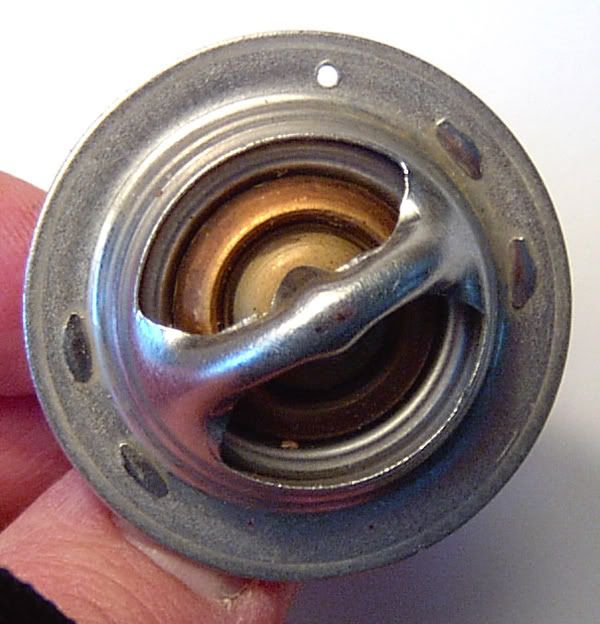This method was developed by trial and error and has been found to be effective to minimize the possibility of trapping air pockets in the L36 3800 engine cooling system. Trapped air could allow for increased temperatures around the hot EGR passage in the plastic upper intake manifold, leading to failure of the manifold, internal coolant leaks, and severe engine damage.
When refilling the engine and radiator with coolant after repair work, remove the radiator cap, then remove the thermostat and drill a small (1/16" - 3/32") bleed hole in the thermostat flange. Make sure the hole is in far enough that it is not covered by the thermostat edge seal.

Check the brass bleeder on the upper radiator hose fitting to make sure it can be opened and closed easily. With the thermostat out, begin filling the engine with coolant at the thermostat housing until the coolant reaches the lip where the thermostat seals. Do not install the thermostat or the upper hose yet. Fill the radiator slowly at the cap opening with coolant. You should see and hear air bubbles disturbing the surface of the coolant in the intake manifold at the thermostat housing as they are pushed up and out of the engine. The coolant level will eventually start to rise in the manifold as the coolant in the radiator gets high enough. When the coolant begins to overflow without falling back below the edge of the opening, install the drilled thermostat, positioning the bleed hole at the 12 O'Clock position. With the thermostat and upper radiator hose installed, pour additional coolant into the radiator slowly, until it rises to the overflow hole in the radiator neck several times. Allow several minutes each time for the top hose to fill and for air to bleed past the small hole in the thermostat flange. Repeat slowly filling at the radiator until the level in the radiator remains steady for five minutes. Pumping the upper radiator hose by squeezing then releasing should cause coolant in the radiator neck to overflow instantly. Fill the overflow tank two or three inches above the "full hot" mark.
Start the engine and bring it to operating temperature. If possible, take the car for a drive. You will be able to tell when the thermostat opens when the top radiator hose gets hot. With the engine at temperature, increase the engine speed to about 2000 rpm as you open the bleeder screw to expel any air. A bubbling or spitting sound indicates air is being bled out of the system. Even if only coolant is expelled when the bleeder is opened, wait a minute or two and try to bleed it a couple more times. Shut off the engine. If the cooling system has no leaks, the level of coolant in the recovery tank will drop as the system pulls in coolant to make up for displaced air and thermal contraction. Bring the level in the recovery tank back up to "full cold" if needed and observe the level daily until it stabilizes.
_________________

1998 3.8 Dodge Caravan 214K
2000 3.3 Dodge Caravan 175K
1949 Plymouth Special Deluxe 4-dr sedan 25K (needs some work!)



